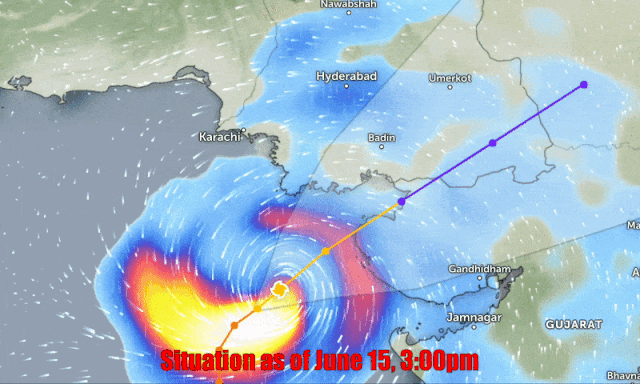Cyclone Biparjoy, officially categorised as a “very severe cyclonic storm,” was projected to make landfall after sunset on Thursday, prompting authorities to remain on high alert.

It had slowed, according to Climate Change Minister Sherry Rehman.
“Cyclone Biparjoy has slowed down, but the core remains intense,” she tweeted. “It will not make landfall before dark.” The National Disaster Management Authority will provide additional information soon.”
#CycloneBiparjoyUpdate : approximately 4 am PST, turning northeast and east as projected, on the border of Pakistan and India. As all arrangements possible to secure lives on the 🇵🇰 impact frontline have been made,praying that as it makes landfall before or by noon, people stay… pic.twitter.com/MjID2KdDSa
— SenatorSherryRehman (@sherryrehman) June 14, 2023
The Pakistan Meteorological Department (PMD) predicted around 3 p.m. that the storm will make landfall between Keti Bandar and India’s Gujarat by evening.
The PMD said the cyclone had travelled north-northeastward over the last six hours and was currently roughly 220 kilometres south of Karachi, 210 kilometres south of Thatta, and 130 kilometres south-southwest of Keti Bandar.
Important developments
- Cyclone 220 km south of Karachi, 210 kilometres south of Thatta, and 130 kilometres south-southwest of Keti Bandar
- According to Sherry Rehman, the hurricane has slowed and will not reach landfall before the night.
- Over 80,000 people have been evacuated, and another cyclone is possible in July.
- Gujarat, India’s westernmost state, has evacuated 75,000 people.
It was predicted that Biparjoy will continue northeastward and cross between Keti Bandar and the Indian Gujarat coast in the evening. The cyclone was expected to bring winds of 100-120 km/h with gusts of up to 140 km/h, according to the warning.
From June 15 to 17, widespread wind-dust/thunderstorm and severe rain were expected in Sindh’s Thatta, Sujawal, Badin, Tharparkar, Mirpurkhas, and Umerkot districts.
It also forecasted dust/thunderstorm and rain in Karachi, Hyderabad, Tando Muhammad Khan, Tando Allayar, Shaheed Benazirabad, and Sanghar districts today and tomorrow (Friday).
Today and tomorrow, dust/thunderstorms and scattered heavy rainfall are expected in Balochistan’s Hub, Lasbela, and Khuzdar districts.
A storm surge of 3-4 metres was forecast at Keti Bander, where the cyclone will make landfall, and its surrounds, according to the weather advisory.
“Sea conditions around the Sindh coast may become extremely rough/high (2-2.5m) and rough/very rough (2m) near the Balochistan coast (Sonmiani, Hub, Kund Malir, Ormara, and neighbouring areas”),” the report added.
Climate Change Minister Sherry Rehman also released a “consolidated report” from all disaster management agencies as well as the weather satellite.
However, the hurricane was expected to make ashore by lunchtime, according to the report. It was also forecast that more than 100mm of rain would fall in Karachi, Hyderabad, Tando Mohammad Khan, Tando Allahyar, Dadu, Shaheed Benazirabad, and Sanghar.
#BiparjoyAlert 4 pm. Distance to Keti Bandar 130 KM; still veering north east. Expected landfall: late night or after midnight. pic.twitter.com/CDmG9TELwp
— SenatorSherryRehman (@sherryrehman) June 15, 2023
Meanwhile, between June 15-17, Thatta, Sajawal, Mirpurkhas, Badin, Umerkot, and Tharparkar are expected to receive more than 300mm of rain.
‘The storm is still unstable and unpredictable.’
Later that day, during a press conference with NDMA Chairman Lt Gen Inam Haider, Rehman stated that Cyclone Biparjoy had moved further away from Karachi, but that the storm remained unpredictable and unstable.
“Its landfall period is variable and has moved further between June 15 and 16,” she explained to reporters.
Rehman stated that the cyclone’s pace and path were changing every hour, and that over 17 stations were currently monitoring it, making Biparjoy the most monitored storm in the world right now.
She went on to say that Biparjoy was still “a very severe cyclonic system in Category 3.” The storm’s persistent wind speed was quite unpredictable, and it was moving north and north-east.
According to the ministry, Karachi will endure heavy rain and severe winds but would not be directly affected by the storm.
Rehman further warned that there were 90 electricity feeders in coastal areas that could fail if the cyclone made landfall. “As a result, teams from Punjab have been called in to assist with repair work.”
Concerning aviation operations, the minister stated that airports in Karachi, Hyderabad, Nawabshah, Sukkur, and Moenjo Daro had been instructed to cease commercial flights if air pressure exceeded 30 nautical knots.
‘More than 80,000 people have been evacuated.’
The climate change minister further stated that with the assistance of the Pakistan Army, Navy, Rangers, and police, 81,935 individuals in critical locations had been relocated.
There are currently 63 active evacuation sites and 106 on standby.
“We are ensuring the provision of cooked food and clean water at the most critical relief camps.” “However, we have also notified medical teams, and 86 units have been deployed in the field,” she continued.
On Geo News’ ‘Geo Pakistan’ on Thursday morning, she stated that Biparjoy was a category three cyclone and that no one knew where it was headed 10 days ago.
She went on to say that all government agencies had taken the threat seriously, and that the cyclone had travelled eastward for the preceding four days.
Rehman encouraged the population to “show unity” and stay away from the sea. “We’ve seen a lot of people go to the beach to witness the cyclone. “Our advice is to avoid sitting near the window,” she said.
These were not “natural climatic conditions,” she claimed.
“I have also been warned that maybe, just maybe, another cyclone will head towards us in July,” she stated, adding that she did not want to cause alarm.
Sindh DCs have been directed to take’mitigation steps.’
The Sindh Provincial Disaster Management Authority directed the deputy commissioners and chairmen of the District Disaster Management Authorities (DDMA) in the Karachi division and the districts of Matiari, Badin, Tando Muhammad Khan, Tando Allahyar, Thatta, Sujawal, Shaheed Benazirabad, Sanghar, Mirpurkhas, Tharparkar, and Umerkot to take “mitigation measures.”
Officials were instructed to keep a close eye on the cyclone and to liaise with the Provincial Emergency Operation Centre (PEOC). They were also directed to organise rescue boats and transportation to help people evacuate from low-lying regions.
The authority requested that fallen trees, wires, and “other loose objects” be removed, as well as that residents of unstable residential structures or mud dwellings be evacuated. It also instructed to identify high-risk regions prone to storm surges and flooding and to organise evacuations appropriately.
Officials were also told to evacuate inhabitants from coastal areas, clean stormwater drains, make sure pumping stations were operating, and remove all billboards.
They were also requested to run a public awareness campaign regarding the cyclone’s potential effects as well as safety precautions.
“Keep fishermen informed of weather conditions and advise them not to venture out into open sea until the situation improves,” the orders stated.
Sindh Chief Minister Murad Ali Shah was also updated on the current storm condition.
According to a handout published by the CM Office, Shah was informed that 76,925 people had been evacuated in Badin, Sujawal, and Thatta, and that 44 relief camps had been established.
India is bracing for a cyclone.
Meanwhile, authorities in Gujarat, India’s westernmost state, have evacuated around 75,000 people from vulnerable coastal towns.
A Reuters witness in the seaside town of Mandvi said that while the winds were high, the sky was blue and the sun was out on Thursday morning, with stores opening and people out on the streets.
“On Thursday morning, wind speeds as high as 90kmph were reported along the Gujarat coast,” a senior India Meteorological Department (IMD) official said.
“The speed will gradually increase over the next few hours to 120km/h, with gusts reaching 135km/h in the afternoon.” We expect landfall in the evening, when winds will be even stronger.”
Auditorium halls in schools and other government buildings were turned into relief camps in both India and Pakistan to give shelter for displaced persons.
The IMD stated in a statement that temporary thatched dwellings in coastal Gujarat might be entirely flattened, while standing crops, plantations, and roadways were predicted to suffer significant damage. Railways could also be disrupted.
Indian authorities have prevented people from utilising beaches and have suspended fishing until Friday.
Many offshore oil plants and major ports along Gujarat’s coast have ceased operations.









